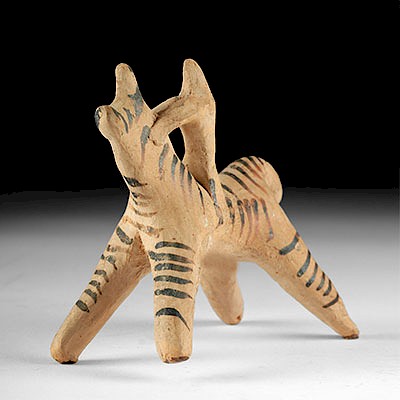Large Chinese Tang Dynasty Terracotta Rooster w/ TL
Lot 159
About Seller
Artemis Fine Arts
686 S Taylor Ave, Ste 106
Louisville, CO 80027
United States
Selling antiquities, ancient and ethnographic art online since 1993, Artemis Gallery specializes in Classical Antiquities (Egyptian, Greek, Roman, Near Eastern), Asian, Pre-Columbian, African / Tribal / Oceanographic art. Our extensive inventory includes pottery, stone, metal, wood, glass and textil...Read more
Categories
Estimate:
$1,000 - $1,500
Absentee vs Live bid
Two ways to bid:
- Leave a max absentee bid and the platform will bid on your behalf up to your maximum bid during the live auction.
- Bid live during the auction and your bids will be submitted real-time to the auctioneer.
Bid Increments
| Price | Bid Increment |
|---|---|
| $0 | $25 |
| $300 | $50 |
| $1,000 | $100 |
| $2,000 | $250 |
| $5,000 | $500 |
| $10,000 | $1,000 |
| $20,000 | $2,500 |
| $50,000 | $5,000 |
| $100,000 | $10,000 |
| $200,000 | $20,000 |
About Auction
By Artemis Fine Arts
Oct 25, 2018
Set Reminder
2018-10-25 11:00:00
2018-10-25 11:00:00
America/New_York
Bidsquare
Bidsquare : Antiquities from Egypt, Greece, Italy, Asia
https://www.bidsquare.com/auctions/artemis-gallery/antiquities-from-egypt-greece-italy-asia-3538
Featuring Egyptian, Greek, Roman, Etruscan, Near Eastern, plus Asian art from Central and Far East. If you love the classics, this is the sale for you. Artemis Fine Arts info@artemisgallery.com
Featuring Egyptian, Greek, Roman, Etruscan, Near Eastern, plus Asian art from Central and Far East. If you love the classics, this is the sale for you. Artemis Fine Arts info@artemisgallery.com
- Lot Description
East Asia, China, Tang Dynasty, ca. 618 to 907 CE. A mold-made terracotta rooster covered with remnants of white slip and faint red details on the head. Rendered in an alert, standing pose with an erect neck, the animal looks straight ahead with delineated wings folded to its abdomen with stylized feathers and presents an overall bold silhouette. Models such as this were known as "ming-ch'i" (or mingqui "spirit animals") and represented a central component of Chinese burial practices. A lovely example with nice traces of surface pigmentation. Size: 10.5" L x 5.75" W x 12.875" H (26.7 cm x 14.6 cm x 32.7 cm).
The subject matter of ming-ch'i are usually related to daily life and attests to the importance of raising livestock in ancient China. The ancient Chinese viewed the afterlife as an extension of their lives on earth, so mingqi reveal details about their daily lives and belief systems over the course of a thousand-year period. Mingqi emerged during the formative Han dynasty (206 BCE to 220 CE) and continued to be created through the turbulent Six Dynasties period (221 to 589 CE) and the later reunification of China in the Sui (589 to 618 CE) as well as the Tang (618 to 906 CE) dynasties. As Xunzi, a follower of Confucius, aptly stated, "One adorns the dead as though they were still living, and sends them to the grave with forms symbolic of life."
This piece has been tested using thermoluminescence (TL) and has been found to be ancient and of the period stated. A full report will accompany purchase.
Provenance: private Boulder, Colorado, USA collection
All items legal to buy/sell under U.S. Statute covering cultural patrimony Code 2600, CHAPTER 14, and are guaranteed to be as described or your money back.
A Certificate of Authenticity will accompany all winning bids.
We ship worldwide and handle all shipping in-house for your convenience.
#134892Repair to part of one foot, with second foot reattached at ankle, and head reattached at neck, all with small chips, light stabilizing material, and light adhesive residue along break lines. Surface wear and abrasions commensurate with age, small nicks to feet, tail, body, and head, with fading to finer details, and losses and fading to pigmentation. Nice earthen deposits throughout. Two TL-test drill holes, one beneath one foot, and one behind tail near top feathers.Condition
- Shipping Info
-
All shipping is handled in-house for your convenience. Your invoice from Artemis Gallery will include shipping calculation instructions. If in doubt, please inquire BEFORE bidding for estimated shipping costs for individual items.
-
- Buyer's Premium



 EUR
EUR CAD
CAD AUD
AUD GBP
GBP MXN
MXN HKD
HKD CNY
CNY MYR
MYR SEK
SEK SGD
SGD CHF
CHF THB
THB
















